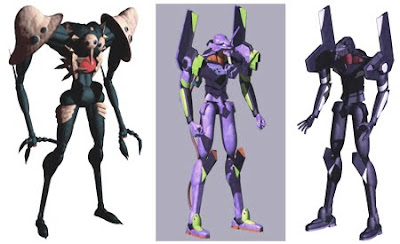Long ago, 1995 I think, I acquired an inexpensive but very satisfying computer graphics program called
KPT Bryce. It was created by
Kai's Power Tools back when they were still joined with an old software company called
Metacreations. It was then in those years that my brief experimentation with CGI began and then quickly ended in part for personal reasons, because I went back to hand-painted art, and because of the ever-shifting and impermanent world of computer software and hardware technologies.

I was running this software on my first Mac, the Apple
6320cd, a cream colored machine that operated on 16 MB OF RAM! AND HAD A HARD DRIVE OF 1.2 GB! I don't think I have a flash drive with less than 2Gb on it. Well, the program was made for rendering landscapes of canyons and islands but also had a few basic geometric primitives like cubes and spheres or even a pyramid shape to drop in your cg desert. One of my earliest creations, that horrifies me now, is a
DUNE themed landscape. This was made quickly with the program's fractal-based land mass generator and the adjustable "atmosphere" controls to make clouds, mist, haze, etc...

So I continued "playing" with Bryce's geometric primitives, which could be elongated, connected, colored and textured. Above is an example of these in an unfinished
Gundam mecha I was designing. It's right leg and arm pieces were assembled separately and the picture probably shows nearly a hundred of these small geometric bits. By current CGI model making standards, it's really time consuming and complex, even if the result looks simple.

Because I'm a huge Star Wars mega-nerd, I went on to make figures from that series. Tho not terribly realistic (they look really funny to me now), I would use these as smaller elements in very complex scenes with buildings, spacecraft, and moons thrown into their synthetic skies. The more familiar creature at the left, a Rodian, had his head first constructed from a larger sphere, his snout from a cylinder attached to the sphere, and then everything else on his face and head made from even more spheres and cylinders, all "pasted" together. The program didn't really provide you with any soft, organic curvy shapes. The curved head of his brown hammer head companion was made by introducing a cylinder or squashed sphere, duplicating it onto an imaginary invisible circular diameter, then duplicating those two elements, rotating them so now the four elements are 90 degrees across from each other, duplicating those into eight pieces, rotate, duplicate, rotate, repeat, repeat, repeat until you have about 100 squashed rounded bits side by side and so close AND even overlapping each other to create a softer torque shaped object. The program didn't have torques. I would then cut off one side of the torque and the half-torque made the hammer-headed curved portion of the head. NIGHTMARE!






















